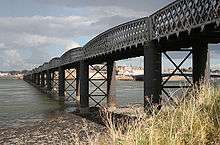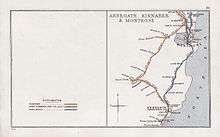North British, Arbroath and Montrose Railway
The North British, Arbroath and Montrose Railway was a company established by Act of Parliament in 1871 to construct and operate a railway line from north of Arbroath via Montrose to Kinnaber Junction, 38 miles (61 km) south of Aberdeen.[3][1] The company was originally a subsidiary of the North British Railway but it was absorbed into its parent in 1880.[1] Construction of the line was delayed and a viaduct had to be dismantled and rebuilt following the Tay Bridge disaster. Rivalry between the companies on the east and west coast routes from London to Aberdeen, the "Race to the North", culminated in 1895 – the crucial point was at Kinnaber Junction where the two routes converged into a single railway.
 The rebuilt South Esk Viaduct | |||||||||||||||||||||||||||||||||||||||||||||||||||||||||||||||||||||||||||||||||||||||||||||||||||||||||||||||||||||||||||||||||||||||||||||||||
| Overview | |||||||||||||||||||||||||||||||||||||||||||||||||||||||||||||||||||||||||||||||||||||||||||||||||||||||||||||||||||||||||||||||||||||||||||||||||
|---|---|---|---|---|---|---|---|---|---|---|---|---|---|---|---|---|---|---|---|---|---|---|---|---|---|---|---|---|---|---|---|---|---|---|---|---|---|---|---|---|---|---|---|---|---|---|---|---|---|---|---|---|---|---|---|---|---|---|---|---|---|---|---|---|---|---|---|---|---|---|---|---|---|---|---|---|---|---|---|---|---|---|---|---|---|---|---|---|---|---|---|---|---|---|---|---|---|---|---|---|---|---|---|---|---|---|---|---|---|---|---|---|---|---|---|---|---|---|---|---|---|---|---|---|---|---|---|---|---|---|---|---|---|---|---|---|---|---|---|---|---|---|---|---|---|
| Locale | Scotland | ||||||||||||||||||||||||||||||||||||||||||||||||||||||||||||||||||||||||||||||||||||||||||||||||||||||||||||||||||||||||||||||||||||||||||||||||
| Dates of operation | 1881[note 1]–remains open[note 2] | ||||||||||||||||||||||||||||||||||||||||||||||||||||||||||||||||||||||||||||||||||||||||||||||||||||||||||||||||||||||||||||||||||||||||||||||||
| Successor | North British Railway | ||||||||||||||||||||||||||||||||||||||||||||||||||||||||||||||||||||||||||||||||||||||||||||||||||||||||||||||||||||||||||||||||||||||||||||||||
| Technical | |||||||||||||||||||||||||||||||||||||||||||||||||||||||||||||||||||||||||||||||||||||||||||||||||||||||||||||||||||||||||||||||||||||||||||||||||
| Track gauge | 1,435 mm (4 ft 8 1⁄2 in) | ||||||||||||||||||||||||||||||||||||||||||||||||||||||||||||||||||||||||||||||||||||||||||||||||||||||||||||||||||||||||||||||||||||||||||||||||
| Length | 16 miles 8 chains (25.91 km)[note 3] | ||||||||||||||||||||||||||||||||||||||||||||||||||||||||||||||||||||||||||||||||||||||||||||||||||||||||||||||||||||||||||||||||||||||||||||||||
| |||||||||||||||||||||||||||||||||||||||||||||||||||||||||||||||||||||||||||||||||||||||||||||||||||||||||||||||||||||||||||||||||||||||||||||||||
Railway line
Effectively a continuation of the North British line over the Tay Bridge, this single-track railway directly connected the older Arbroath and Forfar Railway with the Aberdeen Railway to the north.[1] North British had running rights over the Caledonian Railway to Aberdeen.[4] There was a short branch line to Montrose South Harbour and a junction with the Montrose and Bervie Railway.[1][5] The railway opened in 1881, but for goods traffic only; it did not open fully for passenger traffic until 1 May 1883.[6]
The main station was Montrose railway station, opened in 1883 and quite separate from the Caledonian Railway terminus nearby.[7][8] A station was opened at Lunan Bay, which also served the nearby settlement of Lunan. The opening of the station made access to the area easier than by road. A nearby picturesque feature which has been bridged by the railway is the deep ravine at Buckie Den.[6]
Because the line was largely single track, exchanging tablets was required at five places – St Vigean's, Inverkeilor, Lunan Bay, Montrose and Hillside. Hillside to Kinnaber Junction was built as double track. Each exchange required slowing the train to about 35 mph (56 km/h). The St. Vigean's exchange was removed when the North British Railway doubled the line from there to Inverkeilor in 1897, but it was replaced when a loop was constructed at Usan in 1906, and an exchange introduced there. Even so, travel time from Edinburgh to Aberdeen – over the Forth and Tay bridges and along this line – was reduced by one hour compared with the previous journey via Perth.[9][10]
Viaducts near Montrose
.jpg)
Two viaducts south of Montrose were designed by Sir Thomas Bouch, the architect of the original Tay Bridge, but due to delays in building the Tay Bridge and the line by Dundee, they were not built until 1879.[11] Construction was by Gilkes Wilson and Company supervised by Bouch's son William.[12] The more northerly bridge the South Esk Viaduct, was of iron lattice girder construction.[13][note 4] Following the Tay Bridge disaster of 1879 the viaduct was inspected and found to have a distinct curve, although the plans showed a straight bridge, and many of the piers were out of perpendicular.[11] Tests in 1880 over a period of 36 hours using both dead and rolling loads led to the structure becoming seriously distorted and eight of the piers were declared unsafe.[11][13] It had to be dismantled and rebuilt by Sir William Arrol to a design by W. R. Galbraith before the line could be opened to traffic in 1881.[11][14][15] The replacement was also of wrought iron lattice girder construction based on designs dating back to the 1830s.[11] Such designs were widely used by Victorian engineers until rendered obsolete by the introduction of other American truss designs in the 1880s.[11] South Esk Viaduct at Montrose was probably the last major bridge in the United Kingdom to be built with this type of bracing.[16] The more southerly brick viaduct, the Ferryden Viaduct, was retained.[11]
Kinnaber Junction and the "Race to the North"

In the late 19th century there was considerable competition between the companies on the West Coast lines and those on the East Coast to provide the fastest overnight journey from London (Euston or King's Cross) to Aberdeen.[17] In 1894, with the trains both departing at 20:00, the earlier scheduled arrival time was 08:50 and this became 05:40 in 1895.[17][note 5] The so-called "Race to the North", run over the two rival routes, reached a peak in August 1895.[17] The first train to Kinnaber Junction signalbox, 38 miles (61 km) south of Aberdeen, would always win because from there on, the two routes ran along the same railway.[1][18] The signalman in Kinnaber Junction signalbox was warned of the approach of trains on each route by a telegraphic bell signal from the next signalbox to the south. He could only accept one train at a time, and so if a train then approached on the other route, it would find that the signals were against it.[17] Both trains would approach Kinnaber at closely similar times and sometimes in sight of each other across the Montrose Basin[12] – indeed it is said that on one occasion the two bells rang together.[17]
Present railway line
The line is still in use as part of the East Coast Main Line with trains on the Edinburgh to Aberdeen Line and Glasgow to Aberdeen Line running over it since the two routes now meet at Dundee. The line is the only railway to Aberdeen from the south. It has not been electrified but it is now double track; with the exception of the section from Usan to Montrose Station, over the two Montrose viaducts - which is the only single-track section of the East Coast Main Line.[1][19] The line was doubled in two stages, and three parts. St. Vigean's Junction to Inverkeillor was achieved by the North British Railway on 20 June 1897.[20] But it was left to the LNER to complete the sections from Inverkeillor to Usan Box, and Montrose North to Hillside, between 1928 and 1932.[21]
Notes
- Open for freight. Opened for passengers in 1883.
- The company was amalgamated with its parent company, the North British Railway, before the line opened. The NBR became part of LNER in 1923. The line is substantially still open.
- Including the ½ mile (800m) branch to Montrose South Harbour.
- A "lattice girder bridge" is generally called a "lattice truss bridge" in America
- The 1895 arrival time is, of course, inconveniently early
References
- Crawford, Ewan. "North British, Arbroath and Montrose Railway". A History of Britain's Railways. RAILSCOT. Retrieved 1 April 2013.
- Jowett, Alan (March 1989). Jowett's Railway Atlas of Great Britain and Ireland: From Pre-Grouping to the Present Day (1st ed.). Sparkford: Patrick Stephens Ltd. ISBN 978-1-85260-086-0. OCLC 22311137.
- "North British, Arbroath, and Montrose Railway". London Gazette. 25 November 1870. Retrieved 5 April 2013.
"North British, Arbroath, and Montrose Railway" (PDF). Edinburgh Gazette. 21 November 1871. p. 806. Retrieved 30 March 2013.
"North British, Arbroath and Montrose railway". Glasgow Herald. 11 March 1871. - "East Coast Mainline". UK Railway Lines and Rail Information. UK Railway Lines. 9 January 2013. Retrieved 5 April 2013.
- Crawford, Ewan. "Arbroath and Forfar Railway". A History of Britain's Railways. RAILSCOT. Retrieved 1 April 2013.
- Adam, John; Hay, George (1886). Aberbrothock Illustrated: Being the Round O Etchings in Miniature. Thomas Buncle. Retrieved 1 April 2013.
- "Montrose Station". Canmore. Royal Commission on the Ancient and Historical Monuments of Scotland. Retrieved 6 April 2013.
- "Montrose, Railway Place, 1-4 Caledonian House". Canmore. Royal Commission on the Ancient and Historical Monuments of Scotland. Retrieved 6 April 2013.
- Nock, O.S. (1958). The Railway Race to the North. Ian Allan. pp. 64–65.
- Ferguson, Niall (2000). The Arbroath & Forfar Railway & etc Railways . Oakwood Press. p. .
- Historic Environment Scotland. "Railway Viaducts over South Esk River (Category B) (LB49864)". Retrieved 25 March 2019.
- McKean, Charles (2007). Battle for the North : the Tay and Forth Bridges and the 19th-century railway wars. London: Granta. p. 147. ISBN 9781862079403.
- "Condemnation of a Railway Viaduct". Thames Star. 17 January 1881. Retrieved 5 April 2013.
- "Montrose, South Esk Viaduct". Canmore. Royal Commission on the Ancient and Historical Monuments of Scotland. Retrieved 1 April 2013.
- "Montrose, Ferryden Viaduct". Canmore. Royal Commission on the Ancient and Historical Monuments of Scotland. Retrieved 1 April 2013.
- Rapley, John (June 1998). "James Thomson (1822-1892)". PHEW Newsletter (78). Institution of Civil Engineers, Panel for Historical Engineering Works. Archived from the original on 11 October 2003.
- Tomlinson, William Weaver (1914). The North Eastern Railway; its rise and development. London: Longmans, Green & Company. pp. 734–740.
- Nock, Oswald S. (1975). Locomotion: A World Survey of Railway Traction. Taylor & Francis. p. 91. ISBN 978-0710082220.
- Railway Track Diagrams, Book 1, Scotland (5th ed.). TrackMaps. 2007. p. .
- Thomas, John (1975). North British Railway, Vol 2. David & Charles. p. .
- Hughes, Geoffrey (1986). LNER. Ian Allan [Malaga Books]. p. 37.